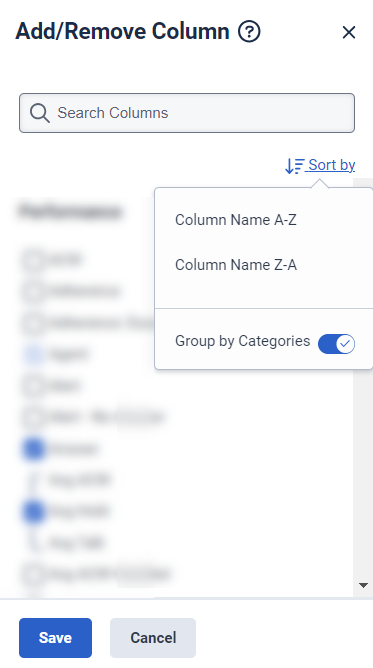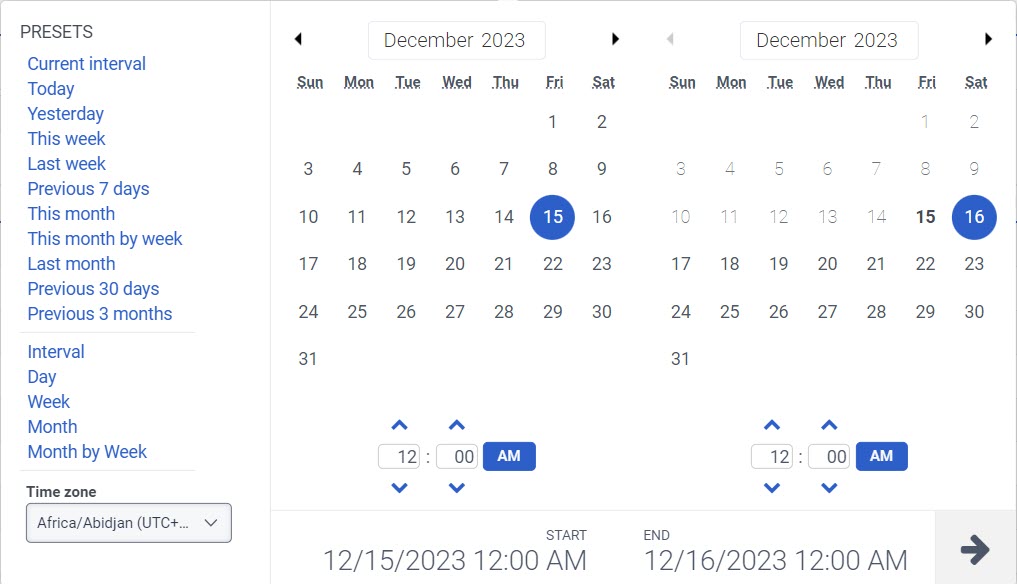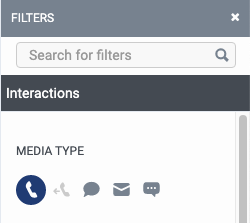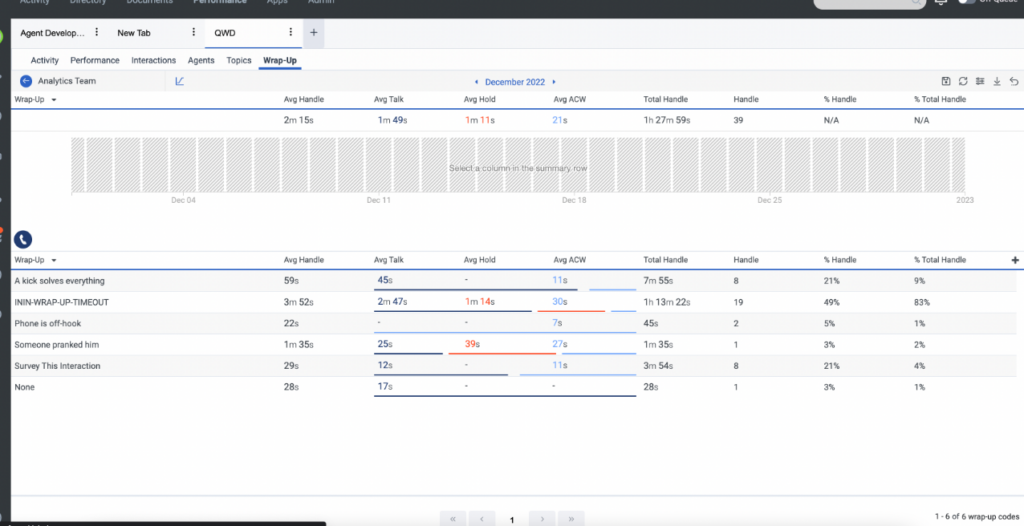Queues Wrap-up detail view
The Queues Wrap-Up Detail view displays exportable wrap-up performance data grouped by the queue. These statistics help supervisors determine queue performance issues with interactions that are set with specific wrap-up codes in one or more queues.
The metrics in each wrap-up code row represent the portion of the interaction where the wrap-up code was selected. For example, Queue-1 answers and then transfers an interaction to Queue-2. Alex then sets a wrap-up code of Transfer to Sales. Blake accepts the transfer and interacts with the customer. The customer ends the call. Blake then sets a wrap-up code of Sale Success. Any metrics associated with Alex’s portion of the interaction appear in the Transfer to Sale wrap-up code row in the Queues Wrap-Up Detail view. Metrics associated with Blake’s portion of the interaction appear in the Sale Success wrap-up code row in his Queues Wrap-Up Detail view.
This view does not update automatically. To see the most current data, click Refresh .
Available columns
To view the available columns, see Queues Wrap-up detail view section in the View available columns in performance views by category article.
To view the consolidated list of available columns in the performance views, see Consolidated view of available columns in performance views.
To view the list of available columns in the performance views by category, see View available columns in performance views by category.
Set a default time zone in the workspace
You can set the default time zone in the analytics workspace before viewing any analytics view.
To set the default time zone in the workspace, follow these steps:
- Click Performance > Workspace.
- On the left side, from the Time zone drop-down menu, select the required time zone as the default time zone for the analytics workspace.
To see the Queues Wrap-Up Detail view:
- Click Performance > Workspace > Contact Center > Queue Performance.
- From the Queues Performance Summary view, click the queue you want to view.
- From the Queues Performance Detail view, click the Wrap-Up tab.
- Near the list of queues you selected, click View as group. Genesys Cloud displays the Queues Performance Detail view with aggregate data for the queues that you selected.
- To export the aggregate data in the view, click Export .
- To save the view with your filter and column settings, click Save .
- To export the data in the view, click Export .
- To see more details about a queue’s performance, click a queue’s name.
- To open the agent’s Performance, Agents, Interactions, or Topics detail views, click the tabs.
Customize the view
To show only certain data, customize the Queues Wrap-Up Detail view. For example, you can choose to show only certain columns or filter to see certain types of interactions. Your customizations remain as you navigate from view to view or leave and return to a view. You can also save your filter and column settings as a saved view to quickly switch between different data of interest in the same view.
To customize analytics views, use the date filter.
To filter metrics by date or configure a custom date range, use presets. When filtering metrics for this view, select any custom date range up to 6 weeks.
To use a preset to filter metrics, complete the following steps:
- To display the date filter, click the date.
- In the Presets list, select a preset date option.
Date presets
| Presets | Description |
|---|---|
| Current interval | Shows data for the current 30-minute time period. |
| Today | Shows data for the time period that includes the current interval. |
| Yesterday | Shows data for the previous day. |
| This week | Shows data for a Sunday through Saturday time period. |
| Last week | Shows data for the previous week, Sunday through Saturday. |
| Previous 7 days | Shows data for the previous seven days. |
| This month | Shows data for the current month, with no extra days. |
| This month by week | Shows data for the current calendar month starting on Sunday and ending on Saturday, including extra days if the month does not start on Sunday or end on Saturday. |
| Last month | Shows data for the previous calendar month with no extra days. |
| Previous 30 days | Shows data for the previous 30 days. |
| Previous 3 months | Shows data for the previous 3 months. For example, Nov 1, 2022 – Jan 31, 2023. |
| Interval | Shows data for a 30-minute time period. |
| Day | Shows data for a single 24-hour day. |
| Week | Shows data for a Sunday through Saturday time period. |
| Month | Shows data for the exact month with no extra days. If the current month is selected, you can see the data up to the current date. |
| Month by Week | Shows data for a calendar month starting on Sunday and ending on Saturday, including extra days if the month does not start on Sunday or end on Saturday. |
To use a custom date range to filter metrics, complete the following steps:
- Click the date to display the date filter.
- Select a start date and an end date on the calendar, and click the filter arrow .
To view data for a different time period using the same date presets, click the arrows on either side of the date display. ![]()
For example, to view data for the previous day, click the Day preset, and then click the arrow on the left side of the date.
To view data for a different time zone using the same date presets, from the Time zone drop-down menu, select the required time zone. You can create and save reports with the same selected time zone.
- When filtering you can select more than one media type. Click the relevant media type to select or deselect the type.
- You cannot select the voice and callback types at the same time.
- If you select voice, the callback option will be deselected. If you select callback, the voice interaction will be deselected.
- The available media types may vary from those shown above.
The selected media type icon is displayed above the column headers. For more information about various media types and their settings, see the Set behavior and thresholds for all interaction types section in the Create and configure queues.
To enter the names of wrap-up codes for the information you want to view, click the Filter by wrap-up code(s) search icon . Enter the name of the wrap-up code and select the name from the search results. You can continue to enter and select additional wrap-up codes to add to the view.
Filter by selecting multiple wrap-up codes
You can select multiple wrap-up codes to filter by.
- In the wrap-up code's row, select the check box.
- Continue selecting wrap-up code check boxes to add to filters.
- Click Add to filters.
To enter the names of queues for the information that you want to view, click the Filter by queue(s) search icon. Enter the name of the queue and select the name from the search results. You can continue to enter and select additional queues to add to the view.
Filter by selecting multiple queues
You can select multiple queues to filter by.
- In the queues row, select the check box.
- Select the appropriate queue checkboxes to add them to the filters.
- Click Add to filters.
Data in the view can be displayed in a chart. To view the chart, click the Show/Hide chart icon .
To show or hide columns:
- Click the Pick columns icon on the right side. The Add/Remove Column pane appears.
- (Optional) To sort the columns in ascending or alphabetical order, click Sort by > Column Name A-Z.
- (Optional) To sort the columns in descending or reverse alphabetical order, click Sort by > Column Name Z-A.
- (Optional) To categorize or uncategorize the columns, click Sort by and enable or disable the Group by Categories toggle. Click the image to enlarge.

- Search or scroll to select the columns you want to view. Note: You can also use keyboard navigation to choose the columns.
- Click Save. The selected columns appear on the screen. Note: The column selections appear only after saving the changes and do not apply to the table immediately.
To rearrange the columns, click a column header and drag it.
To reset a view to default column settings, click Reset view to defaults ![]() .
.
You can select up to 20 columns.
For more information about the metrics shown in the columns, see the Available Columns section in this article.
The top of the view displays the totals for your selected date range. To display a graph of a metric per interval within the date range, select a metric in the totals row.
In the graph:
- View the metrics by interval for the selected metric.
- View the highest and lowest intervals for the selected date range, as shown by and above the bars.
- View talk, hold, and ACW metrics in relation to handle metrics.
- To see numeric information, hover over the bars.
To filter by information about the interaction, click the Filter , and then search or scroll to select the filter you want to use.
Interaction filters
| Filter | Description |
|---|---|
| Skills |
Displays metrics for interactions with agents who have the selected skills. Filter for multiple skills at one time by entering other skills and searching again. |
| Languages |
Displays metrics for interactions with agents who have the selected languages. Filter for multiple languages at one time by entering other languages and searching again. |
| DNIS |
Displays information for interactions with the selected DNIS numbers.
|
| Session DNIS |
Displays information for interactions with the selected DNIS number. The DNIS number could have been dialed any time during the interaction.
|
| Direction | Displays information about interactions of the selected directions. |
| Initial Direction | Displays information about interactions with the selected initial direction. |
| User | Displays information associated with the selected users. Filter for multiple users at one time by entering other users and searching again. To see and select inactive users in the User filter search, select Include inactive users. To see and select deleted users in the User filter search, select Include deleted users. |
| Message Type | Displays metrics for interactions of the selected ACD message type. This filter only appears if you set the media type filter to Message. If you do not have any message types selected, the view displays information for all message types. Genesys Cloud currently supports the following message types: Facebook, Instagram, Line, Open, SMS, Web Messaging, WhatsApp, and X (Twitter). Note: Line message type is deprecated. But we still support display filtering. |
| Provider |
The source provider for the conversation. For example, Genesys Cloud EMAIL, Edge, and so on. |
| Routing Used |
Displays the routing method that was used to get to the agent who answered the interaction. The routing data is relevant beginning September 5, 2020. |
| Routing Requested | Displays the routing methods that were requested for the interaction. Gives insight into each of the routing methods the conversation went through prior to being answered, abandoned, or flow-out. The routing data is relevant beginning September 5, 2020. |
To filter by outbound information about the interaction:
- Click the Filter .
- Click the Outbound tab.
- Search or scroll to select the filter that you want to use.
Outbound filters
| Filter | Description |
|---|---|
| Campaign Name | Displays interactions associated with the selected campaigns. When you type a campaign name, the suggested campaigns are displayed with their campaign types, Voice, Email, or SMS. Email campaign type: Display interactions for multiple campaigns by entering other campaign names and searching again. |
| Contact List | Displays interactions associated with the selected contact lists. |
| Contact ID | Displays interactions associated with the selected contact IDs. |
To filter by information about the Predictive Engagement journey details of the interaction:
- Click Toggle filters panel .
- Click the Journey tab.
Journey filters
| Filter | Description |
|---|---|
| Has Customer Journey Data | Displays data for interactions that have customer journey data related to Predictive Engagement. |
| Proactive | Displays data for interactions where Predictive Engagement offered a chat during a customer's website visit based on the Predictive Engagement action map settings. |




